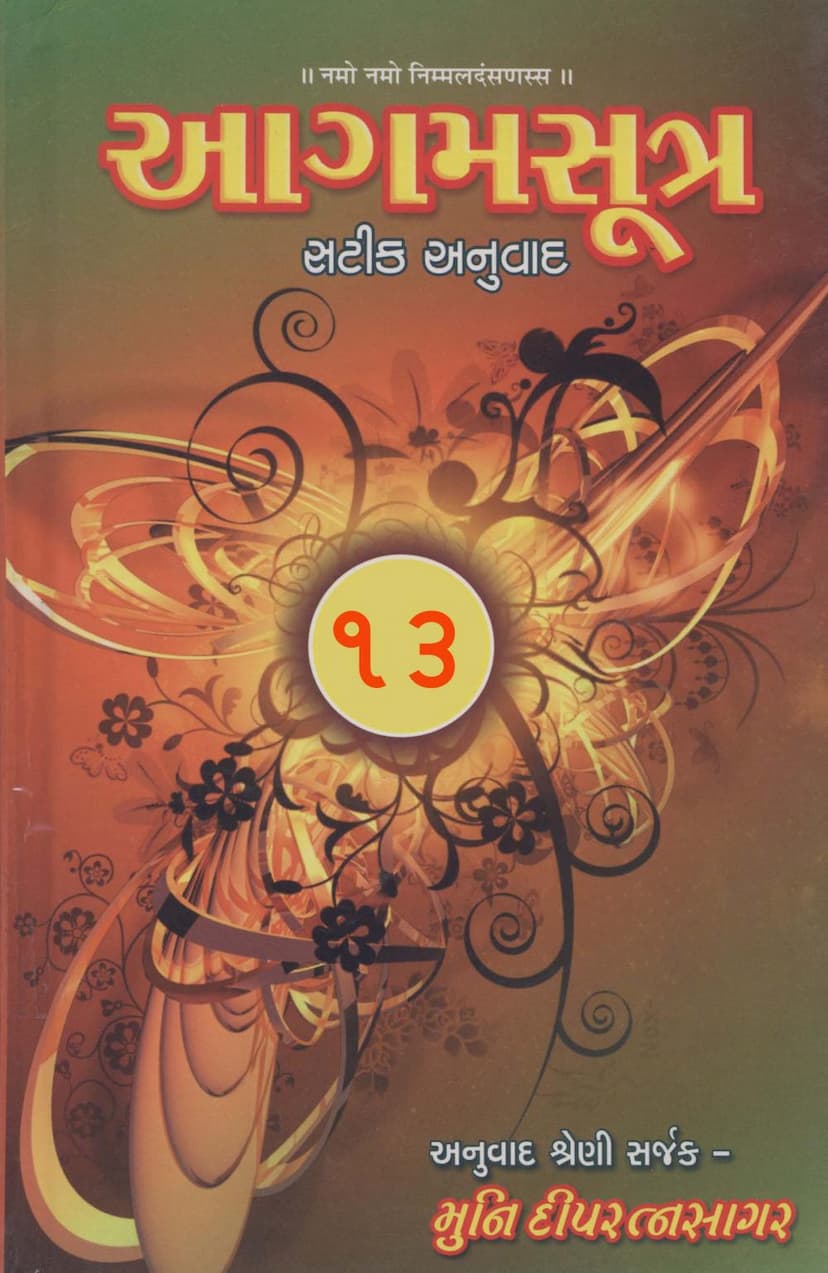Agam Satik Part 13 Bhagavati Sutra Gujarati Anuwad 5
Added to library: September 1, 2025

Summary
This summary outlines the content of "Agam Satik Part 13 Bhagavati Sutra Gujarati Anuwad 5," a Jain text translated by Muni Deepratnasagar.
Core Content:
The primary focus of this volume is the Bhagavati Sutra (also known as Viyaha Pannatti or Vivah Panņatti), the fifth Anga Sutra in Jainism. This particular part, Volume 13, covers Shatakas (chapters/sections) 21 through 41 of the Bhagavati Sutra.
Key Themes and Topics:
The Bhagavati Sutra is known for its question-and-answer format, primarily dealing with diverse philosophical, cosmological, and ethical topics discussed by Lord Mahavir. This volume, based on the provided text, delves into:
- Discussions on various forms of existence and origin: The text meticulously details the origins and characteristics of different types of beings, including:
- Akaaya (souls/living beings) and Pudgala (matter): The text explores their interactions, states of being (kṛta-yuga, srauja, dvāpara-yuga, kali-yuga), and the number of pradeshas (spatial units) they occupy.
- Various hellish beings (Nairayikas) and celestial beings (Vyantaras, Jyotishkas, Vaimanikas): It extensively discusses their origins, rebirths, lifespan, the types of karmas they bind, their sensory perceptions, thought processes, and their states of being (e.g., satejasi, satejasas).
- One-sensed beings (ekendriyas): This includes detailed discussions on permutations related to their existence (bhava-siddhik vs. abhava-siddhik), colorations (leshya), karmic activities (bandha, veda, udra, udiraṇa), and the influence of different types of karmas.
- Samyata (ascetics) and their classifications: The text categorizes ascetics into various types like Pulaka, Kusha, Kushila, Nirgranth, and Snataka, detailing their practices, limitations, knowledge, stages of spiritual development, and how they traverse different life-forms and karmic states.
- Karmic theories and their application: A significant portion of the text is dedicated to explaining the intricate workings of Jain karma. This includes:
- The types of karmas bound, experienced, and their modes of operation (bandha, veda, udra, udiraṇa).
- How different states of existence, sensory perceptions, mind-actions, and karmic stages influence karma.
- The concept of apahar (subsistence or sustenance) and its relation to the lifespan and rebirth of beings.
- Cosmological and Existential Classifications: The text uses the concept of "Yugas" (Kṛta-yuga, Srauja, Dvāpara-yuga, Kali-yuga) to classify and describe the characteristics and origins of various beings. This classification is applied extensively to understand different entities within the Jain universe.
- Detailed Analysis of Jain Principles: The summary highlights discussions on:
- Leshya (coloring of the soul): The text explores the relationship between different leshyas (black, blue, grey, yellow, red, white) and beings' karmic actions and existential states.
- Samyata (asceticism) and its stages: It categorizes ascetics and discusses their spiritual progress, knowledge, and liberation.
- Causality and Karma: The text emphasizes the concept of karma-bandha (karmic bondage) and how actions in this life determine future existences, with a detailed breakdown of how different states of being, leshyas, and stages of spiritual practice influence these karmic processes.
- Avagahana (spatial extension), Sthiti (lifespan), and Sambandha (connection): These concepts are frequently used to describe and differentiate between various beings and their karmic interactions.
- Upapāta (birth/origin) and Vyakrānti (transfer/transition): The text extensively analyzes the pathways of transmigration and rebirth for various beings, often tracing their origins from one life-form or realm to another.
Structure and Methodology:
The text follows a structured approach, likely a question-and-answer format between Lord Mahavir (Bhagavan) and his disciple Lord Gautama, or other disciples. The discussions are organized by categories of beings, their existential states, karmic activities, and spiritual classifications.
Overall Purpose:
This volume serves as a detailed exposition of Jain philosophy, emphasizing the principles of karma, rebirth, spiritual development, and the intricate workings of the universe as understood within the Jain tradition. It aims to provide a deep understanding of these concepts through exhaustive analysis and numerous examples.
Note: The provided text is a detailed summary of the Gujarati translation. A direct translation of the original Prakrit or Sanskrit would be more comprehensive but this summary captures the essence of the translated content. The repeated emphasis on "purvavata" (as stated before) suggests that many topics are explained in detail in earlier sections of the Bhagavati Sutra and then referenced here for consistency.